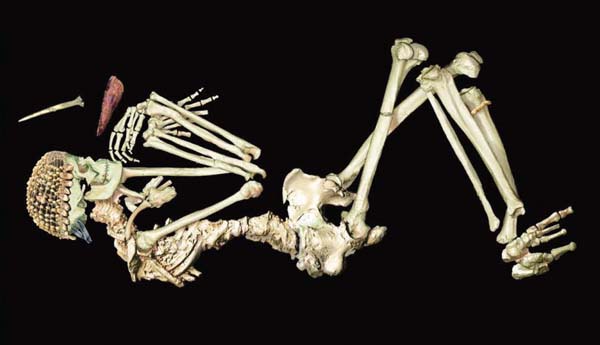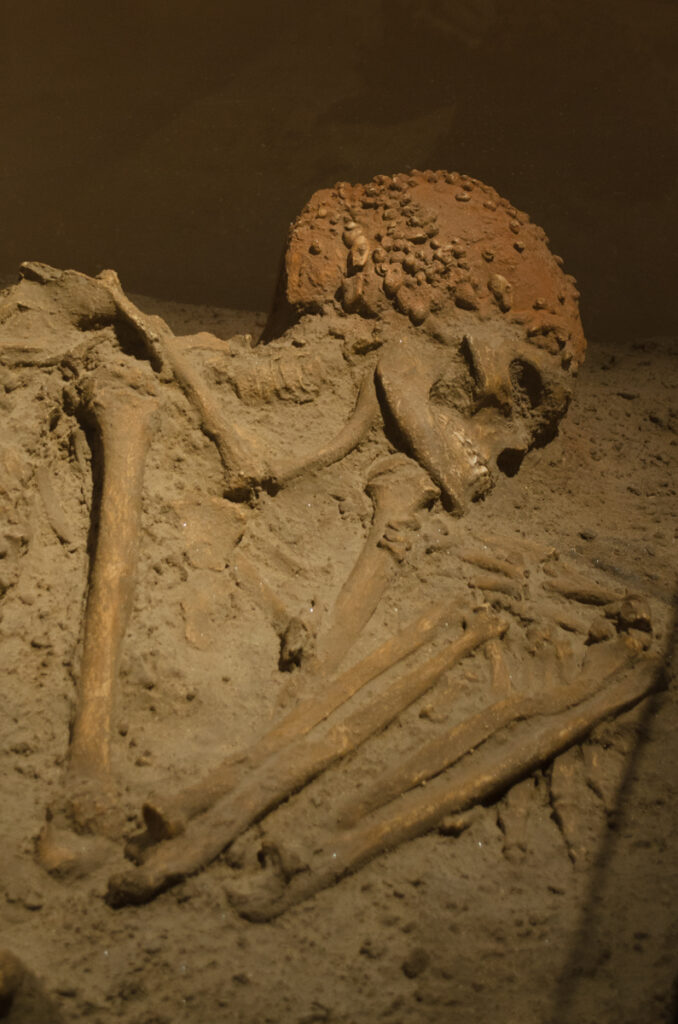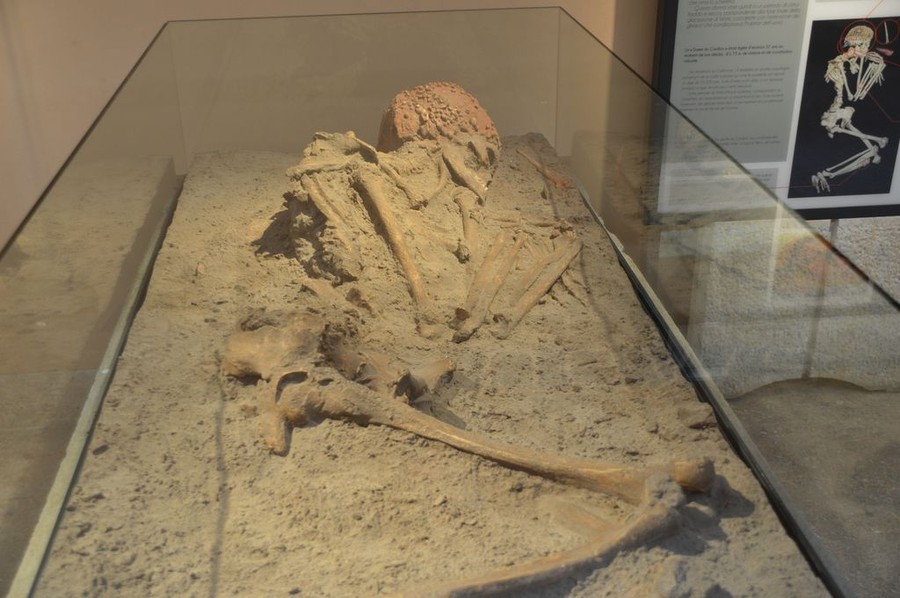Introduction
Buried deep within the Caviglione cave, part of the Balzi Rossi archaeological site on the Italian-French border, lies a remarkable discovery that has captivated the imagination of historians, archaeologists, and the public alike. The “Lady of Caviglione,” a female skeleton dating back approximately 24,000 years, has shed invaluable light on the lives and customs of our prehistoric ancestors.

This intriguing figure, initially referred to as the “Man of Menton,” was unearthed on March 26, 1872, during excavations led by the renowned French archaeologist Emile Riviere. It was not until DNA examination that the true identity of this individual was revealed – a tall woman who had likely borne children, standing between 170-172 cm tall and around 37 years old at the time of her death.
The Lady of Caviglione’s burial, replete with intricate ornaments and ceremonial elements, suggests that she may have held a special status within her Epigravettian society, possibly as a shaman or spiritual leader. In this comprehensive blog post, we will delve into the captivating story of this ancient woman, exploring the insights her remains have provided into the lives and beliefs of our prehistoric ancestors.
The Epigravettian Culture and the Würm Glaciation
The Lady of Caviglione belonged to the Epigravettian culture, which emerged and flourished during the final phase of the Würm glaciation, the last major ice age that gripped the European continent. This period, characterized by a cold and dry climate, saw the maximum expansion of the ice sheets, dramatically shaping the landscape and the way of life for the human inhabitants of the region.

The Epigravettian culture, named after the Gravettian tradition that preceded it, was a hunter-gatherer society that adapted to the challenging environmental conditions of the time. These resilient people relied on a diverse range of resources, from hunting large game such as mammoths and woolly rhinoceros to gathering wild plants and foraging for marine life along the coast.
The Balzi Rossi archaeological site, where the Lady of Caviglione was discovered, was a hub of Epigravettian activity, with numerous caves and rock shelters serving as settlements and burial grounds for these ancient communities. The region’s strategic location, nestled between the Mediterranean Sea and the rugged terrain of the Italian-French border, provided a rich and varied resource base that supported the Epigravettian way of life.
The Discovery and Identification of the “Lady of Caviglione”
The story of the Lady of Caviglione’s discovery begins on March 26, 1872, when the French archaeologist Emile Riviere led a team of excavators to the Caviglione cave, part of the Balzi Rossi complex. During their meticulous exploration of the site, the team uncovered a remarkable burial, initially referred to as the “Man of Menton.”
The skeleton, which was found in a crouched position, facing west with hands close to the face and legs folded, was adorned with a stunning ornamental headband. This headband, crafted with great care and attention to detail, featured 300 shells of the Cyclope neritrea, a type of marine gastropod mollusk typically found on sandy beaches. The shells had been meticulously drilled and strung together, with a fringe of red deer teeth (known as “pearl teeth”) adorning the edges.

The body was also covered in red ocher, a pigment commonly used in prehistoric burial rituals, further suggesting the ceremonial nature of the interment. These unique burial practices and the exceptional preservation of the remains captivated the archaeological community, sparking a flurry of interest and speculation about the identity and significance of this ancient individual.
It was not until the advent of modern DNA analysis that the true identity of the “Man of Menton” was finally revealed. Genetic testing conducted in the early 21st century conclusively determined that the skeleton belonged to a woman, not a man, who had likely borne children during her lifetime. This remarkable discovery challenged the long-held assumption about the individual’s gender and shed new light on the role and status of women in Epigravettian society.
The Significance of the Lady of Caviglione’s Burial
The burial of the Lady of Caviglione offers a wealth of insights into the beliefs, practices, and social structure of the Epigravettian people who inhabited the Balzi Rossi region thousands of years ago. The intricate and carefully executed nature of her interment suggests that she may have held a special status within her community, potentially as a shaman or spiritual leader.
The ornamental headband, adorned with hundreds of carefully crafted shells and deer teeth, is a testament to the artistic and technological prowess of the Epigravettian people. The choice of materials, such as the marine gastropod shells and red deer teeth, also hints at the symbolic and spiritual significance of these objects in the burial rituals of the time.

The positioning of the body, with the hands close to the face and the legs folded, is a common feature of Epigravettian burials, suggesting a shared set of beliefs and practices surrounding the afterlife and the treatment of the deceased. The use of red ocher, a pigment associated with purification and transformation in many ancient cultures, further underscores the ceremonial and spiritual aspects of the Lady of Caviglione’s burial.
Moreover, the discovery of this female skeleton, initially mistaken for a male, challenges the often-held assumption that prehistoric societies were predominantly patriarchal. The Lady of Caviglione’s potential status as a shaman or spiritual leader suggests that women in Epigravettian culture may have held positions of significant influence and importance within their communities.
Insights into the Life and Times of the Lady of Caviglione
The Lady of Caviglione’s remains have provided valuable insights into the lives and experiences of the Epigravettian people who inhabited the Balzi Rossi region during the final phase of the Würm glaciation. Through the analysis of her skeletal remains and the artifacts found in her burial, researchers have been able to piece together a more comprehensive understanding of her life and the world in which she lived.
One of the most striking features of the Lady of Caviglione is her stature. Standing between 170-172 cm tall, she was a remarkably tall individual for her time, a testament to the resilience and adaptability of the Epigravettian people. Her height, along with the likelihood that she had borne children, suggests that she may have been a respected and influential member of her community.

The analysis of her skeletal remains has also revealed information about her age and health. At the time of her death, the Lady of Caviglione was approximately 37 years old, a relatively advanced age for a person living during the Würm glaciation. This longevity may have contributed to her elevated status within her society, as older individuals were often revered for their wisdom and experience.
Furthermore, the absence of any visible signs of trauma or disease on her skeleton indicates that the Lady of Caviglione likely enjoyed a relatively healthy and well-nourished life, despite the challenging environmental conditions of the time. This suggests that the Epigravettian people had developed effective strategies for subsistence and healthcare, allowing them to thrive in the harsh climates of the final Würm glaciation.
The Legacy of the Lady of Caviglione
The discovery and study of the Lady of Caviglione have had a profound impact on our understanding of the Epigravettian culture and the lives of our prehistoric ancestors. This remarkable individual has become a symbol of the resilience, ingenuity, and spiritual beliefs of the people who inhabited the Balzi Rossi region thousands of years ago.
The intricate burial rituals and the potential status of the Lady of Caviglione as a shaman or spiritual leader have sparked a deeper appreciation for the complexity and sophistication of Epigravettian society. Her story has challenged long-held assumptions about the role of women in prehistoric cultures and has contributed to a more inclusive and nuanced understanding of the past.

Moreover, the Lady of Caviglione’s legacy extends beyond the academic realm, captivating the public’s imagination and inspiring a deeper connection with our shared human history. Her story has been the subject of numerous publications, exhibitions, and even artistic interpretations, ensuring that her memory and the insights she has provided continue to resonate with people around the world.
As we continue to uncover and study the remains of our prehistoric ancestors, the Lady of Caviglione stands as a testament to the enduring power of archaeological discovery. Her story reminds us of the importance of preserving and honoring the past, for it is through the exploration of our shared heritage that we can gain a deeper understanding of the human experience and the remarkable resilience of our species.
Conclusion
The Lady of Caviglione, a remarkable individual who lived approximately 24,000 years ago, has left an indelible mark on our understanding of the Epigravettian culture and the lives of our prehistoric ancestors. Her discovery, initially misidentified as a male, has challenged long-held assumptions and shed new light on the role and status of women in these ancient societies.
The intricate burial rituals and the potential significance of the Lady of Caviglione as a shaman or spiritual leader have captivated the imagination of historians, archaeologists, and the public alike. Her story serves as a testament to the resilience, ingenuity, and spiritual beliefs of the Epigravettian people who thrived during the final phase of the Würm glaciation.
As we continue to uncover and study the remains of our prehistoric past, the Lady of Caviglione will undoubtedly continue to inspire and captivate, reminding us of the enduring power of archaeological discovery and the importance of preserving and honoring our shared human heritage.

